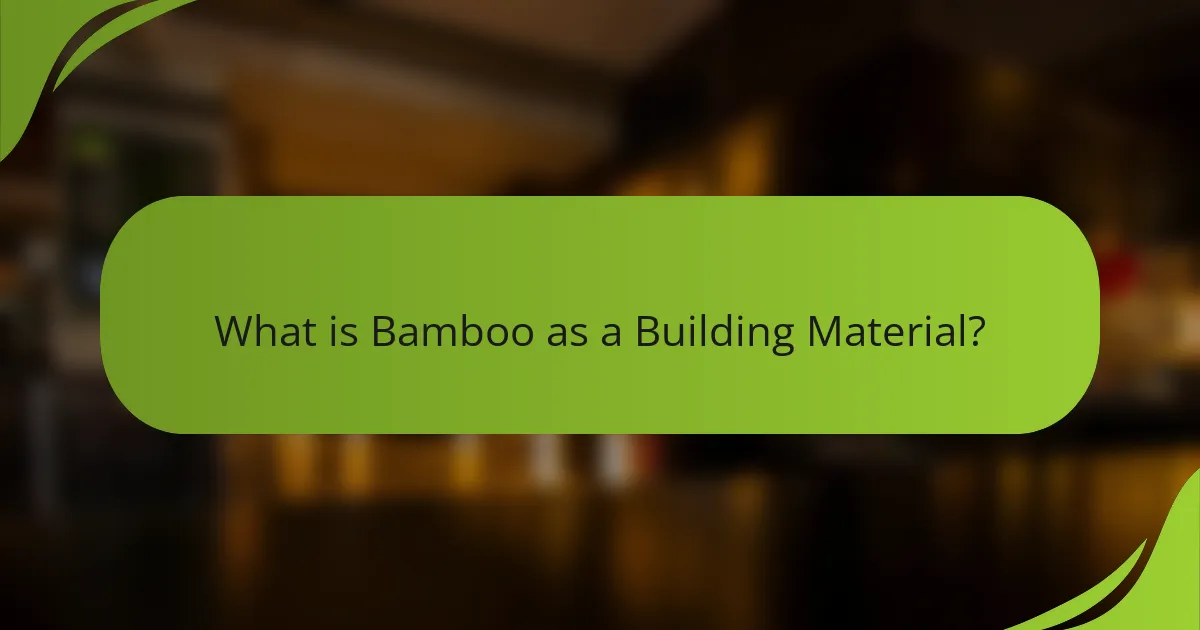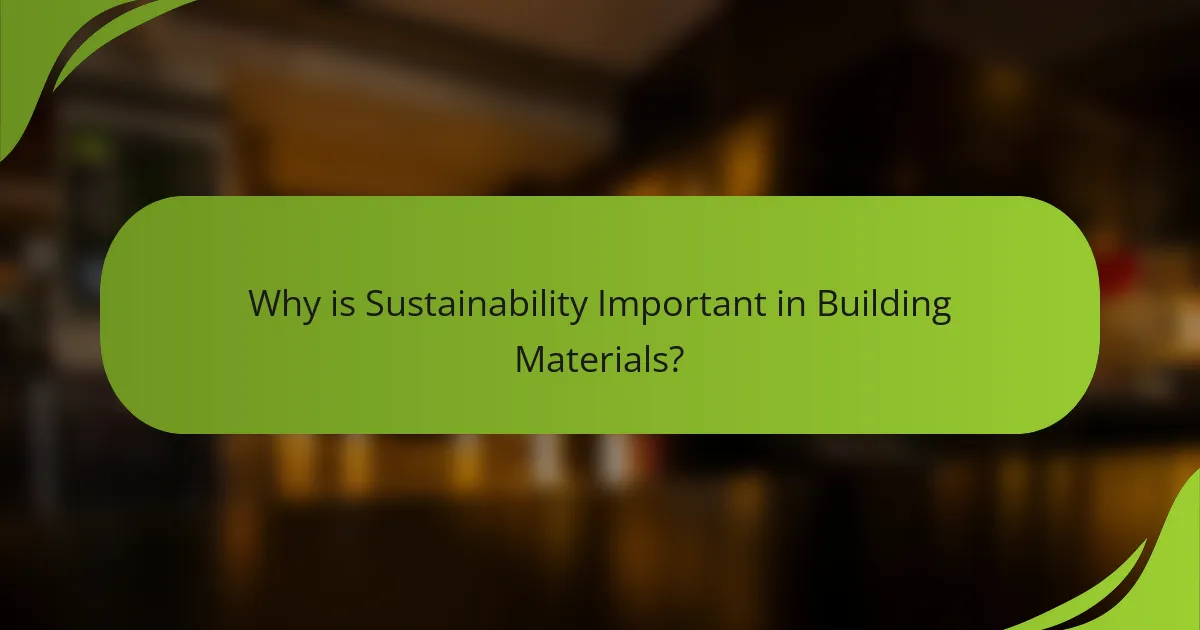Bamboo is a sustainable building material derived from the fast-growing bamboo plant, recognized for its high strength-to-weight ratio and versatility in construction applications. This material is suitable for structural elements, flooring, and decorative features, and its natural flexibility allows it to withstand seismic forces, making it particularly valuable in earthquake-prone regions. Bamboo’s rapid growth cycle of three to five years enhances its sustainability compared to traditional timber, which can take decades to mature. Additionally, bamboo contributes to environmental health by absorbing carbon dioxide during its growth. The increasing use of bamboo in construction aligns with the need for sustainable materials that minimize environmental impact and promote energy efficiency, offering long-term ecological and economic benefits.

What is Bamboo as a Building Material?
Bamboo is a versatile and sustainable building material derived from the fast-growing bamboo plant. It is known for its high strength-to-weight ratio, making it suitable for various construction applications. Bamboo can be used in structural elements, flooring, and decorative features. Its natural flexibility allows it to withstand seismic forces, which is crucial in earthquake-prone areas. Bamboo grows rapidly, reaching maturity in three to five years, which enhances its sustainability compared to traditional timber sources. Studies show that bamboo absorbs carbon dioxide during its growth, contributing to environmental health. The use of bamboo in construction is gaining popularity due to its renewable nature and low environmental impact.
How is bamboo harvested and processed for construction?
Bamboo is harvested by cutting mature stalks at the base. This is typically done during the dry season for optimal quality. The harvesting process requires careful selection of bamboo species and age. After cutting, the bamboo is stripped of its leaves and branches. This ensures that the stalks are clean for processing.
Next, the bamboo undergoes a treatment process to prevent pests and decay. Common treatments include soaking in water or using chemical preservatives. Once treated, the bamboo is dried to reduce moisture content. This drying process can be done in the sun or using kilns.
After drying, the bamboo is ready for construction. It can be cut into various lengths and shapes for different applications. The processed bamboo is strong and lightweight, making it suitable for structural use. Its versatility allows it to be used in flooring, scaffolding, and even furniture.
What tools and techniques are used in bamboo harvesting?
Bamboo harvesting employs various tools and techniques. Common tools include machetes, saws, and knives for cutting bamboo stalks. Specialized harvesting knives, known as bamboo cutters, are designed for precision. Techniques involve assessing bamboo maturity before cutting for optimal quality. Workers usually harvest bamboo in the dry season to minimize moisture content. Use of ropes or harnesses aids in climbing tall bamboo plants. Proper safety gear is essential to prevent injuries during harvesting. These methods ensure efficient and sustainable bamboo collection.
How does the processing of bamboo enhance its properties?
Processing bamboo enhances its properties by increasing its durability and strength. Treatments such as heat and chemical processes remove moisture and pests. This reduces the likelihood of decay and insect damage. Additionally, processing can improve bamboo’s resistance to fire and fungi. The physical structure is altered, making it more suitable for construction. For example, treated bamboo can achieve a compressive strength comparable to concrete. Studies show that processed bamboo has a higher tensile strength than untreated bamboo. This makes it a viable alternative to traditional building materials.
What are the key properties of bamboo that make it suitable for building?
Bamboo is suitable for building due to its high strength-to-weight ratio, flexibility, and rapid growth. Its tensile strength is comparable to steel, making it a strong material for structural applications. Bamboo also exhibits excellent flexibility, allowing it to withstand earthquakes and strong winds. Additionally, bamboo grows quickly, reaching maturity in three to five years, which supports sustainable building practices. The natural resistance to pests and decay further enhances its durability. Bamboo’s lightweight nature simplifies transportation and construction processes. These properties make bamboo an efficient and eco-friendly choice for modern building projects.
How does bamboo’s tensile strength compare to traditional materials?
Bamboo’s tensile strength is superior to many traditional materials, including concrete and steel. Specifically, bamboo can have a tensile strength of up to 500 MPa. In comparison, steel has a tensile strength of approximately 400 MPa. This makes bamboo a strong alternative for construction purposes. Additionally, bamboo’s lightweight nature contributes to its efficiency as a building material. Studies show that bamboo can withstand significant stress while maintaining flexibility. This unique combination of strength and flexibility is often not found in traditional materials. Therefore, bamboo presents a compelling option in sustainable construction.
What is the natural durability of bamboo against environmental factors?
Bamboo has a natural durability that allows it to resist environmental factors such as moisture, pests, and decay. This durability is primarily due to its high silica content and natural oils. Studies show that treated bamboo can last over 20 years in outdoor conditions. Untreated bamboo, however, has a shorter lifespan, typically around 5 to 10 years. Bamboo’s durability can be enhanced through proper treatment methods like carbonization or chemical preservation. These treatments increase resistance to termites and fungal attacks. Overall, bamboo’s natural properties make it a viable option for sustainable building materials.

Why is Sustainability Important in Building Materials?
Sustainability is crucial in building materials because it reduces environmental impact. Sustainable materials minimize resource depletion and promote ecological balance. They often have lower carbon footprints compared to conventional materials. For instance, bamboo grows rapidly and can be harvested in three to five years. In contrast, traditional timber may take decades to mature. Using sustainable materials can also enhance energy efficiency in buildings. According to the World Green Building Council, sustainable building practices can reduce greenhouse gas emissions by up to 40%. This shift not only protects ecosystems but also supports healthier living environments. Overall, prioritizing sustainability in building materials fosters long-term ecological and economic benefits.
How does bamboo contribute to sustainable building practices?
Bamboo contributes to sustainable building practices through its rapid growth and renewability. It can grow up to 91 cm in a single day, making it one of the fastest-growing plants. This quick growth allows for a sustainable supply of material without long replanting cycles. Bamboo also sequesters carbon dioxide during its growth, reducing greenhouse gases.
Additionally, bamboo requires minimal pesticides and fertilizers, leading to less environmental pollution. Its strength-to-weight ratio is higher than that of steel, providing durability while using less material. Bamboo’s natural properties also offer excellent insulation, reducing energy consumption in buildings. Furthermore, it can be harvested sustainably without damaging the ecosystem, as it can regrow from its root system.
What are the environmental benefits of using bamboo over conventional materials?
Bamboo offers significant environmental benefits compared to conventional materials. It is a fast-growing plant, capable of reaching maturity in three to five years. This rapid growth rate allows for sustainable harvesting without deforestation. Bamboo absorbs more carbon dioxide and releases more oxygen than many trees, contributing to improved air quality.
Additionally, bamboo requires less water than traditional timber crops. It can thrive in a variety of climates, reducing the need for chemical fertilizers and pesticides. Bamboo’s strong root system prevents soil erosion, promoting land stability.
According to the Food and Agriculture Organization (FAO), bamboo can produce up to 35% more biomass per hectare than conventional timber. This efficiency makes bamboo a more sustainable choice for construction and other applications.
How does bamboo cultivation impact local ecosystems?
Bamboo cultivation positively impacts local ecosystems by enhancing biodiversity and improving soil quality. The rapid growth of bamboo provides habitat for various species, including birds and insects. Bamboo roots help prevent soil erosion, maintaining land stability. Additionally, bamboo’s ability to sequester carbon contributes to climate regulation. Studies show that bamboo can improve soil fertility through its leaf litter, which adds organic matter. The cultivation process also promotes sustainable land use, reducing the need for deforestation. In regions where bamboo is grown, local water cycles can be positively affected by increased moisture retention in the soil. Overall, bamboo cultivation fosters a healthier ecosystem.
What certifications and standards apply to bamboo as a sustainable material?
Bamboo as a sustainable material is subject to several certifications and standards. The Forest Stewardship Council (FSC) certification ensures sustainable forest management practices. The Sustainable Forestry Initiative (SFI) also promotes environmentally responsible forestry. The Global Organic Textile Standard (GOTS) applies to bamboo textiles, ensuring organic status. The ISO 14001 standard focuses on effective environmental management systems. Additionally, the International Organization for Standardization (ISO) provides guidelines for bamboo products. These certifications and standards help verify the sustainability of bamboo as a building material.
What organizations certify bamboo products for sustainability?
Organizations that certify bamboo products for sustainability include the Forest Stewardship Council (FSC) and the Global Organic Textile Standard (GOTS). The FSC ensures responsible management of forests, including bamboo, promoting sustainable practices. GOTS certifies organic textiles, including those made from bamboo, ensuring environmentally and socially responsible production. Additionally, the Rainforest Alliance provides certification for sustainable agriculture, which can apply to bamboo cultivation. These organizations help consumers identify sustainably sourced bamboo products.
How do these certifications affect consumer choice?
Certifications significantly influence consumer choice in the bamboo building material market. They provide assurance regarding the sustainability and quality of the product. Certifications like FSC (Forest Stewardship Council) indicate responsible sourcing practices. Consumers often prefer certified products due to increased environmental awareness. Studies show that 66% of consumers are willing to pay more for sustainably sourced materials. Certifications help differentiate bamboo products in a crowded market. They enhance brand credibility and trust among consumers. As a result, certified bamboo products often see higher sales and customer loyalty.

What are the Applications of Bamboo in Construction?
Bamboo is used in construction for its strength, flexibility, and sustainability. It serves as a primary material for structural frameworks, flooring, and roofing. Bamboo’s tensile strength is comparable to steel, making it suitable for load-bearing applications. It is also utilized in scaffolding due to its lightweight nature. In some regions, bamboo is crafted into furniture and decorative elements within buildings. Its rapid growth rate contributes to its sustainability as a building material. Studies show that bamboo can reduce carbon footprints in construction projects. Additionally, bamboo’s natural resistance to pests and decay enhances its durability in various climates.
In which types of buildings is bamboo commonly used?
Bamboo is commonly used in residential, commercial, and agricultural buildings. In residential buildings, bamboo serves as a sustainable alternative to traditional materials. It is often used in houses, cottages, and eco-friendly homes. In commercial buildings, bamboo is utilized for offices, restaurants, and retail spaces. Its aesthetic appeal and strength make it a popular choice. Agricultural buildings also incorporate bamboo for structures like barns and storage facilities. Bamboo’s versatility and rapid growth contribute to its widespread use in various building types.
What are the advantages of using bamboo in residential construction?
Bamboo offers several advantages in residential construction. It is a highly sustainable material due to its rapid growth rate. Bamboo can grow up to 91 cm in a single day. This makes it a renewable resource that can be harvested every three to five years. Additionally, bamboo has a high strength-to-weight ratio. It is stronger than steel in tension and comparable to concrete in compression. This strength contributes to the durability of structures built with bamboo. Bamboo also has excellent seismic resistance, making it suitable for earthquake-prone areas. Furthermore, using bamboo can reduce carbon footprints. It absorbs significant amounts of carbon dioxide during its growth. Lastly, bamboo is cost-effective, often requiring less investment compared to traditional building materials.
How is bamboo utilized in commercial and public structures?
Bamboo is utilized in commercial and public structures primarily for its strength, flexibility, and sustainability. It serves as a structural element in beams, columns, and trusses. Bamboo’s lightweight nature allows for easy transportation and installation. Many architects favor bamboo for its aesthetic appeal and natural look.
In regions like Asia and South America, bamboo is a traditional building material. It has been used in schools, community centers, and pavilions. Bamboo structures can be designed to withstand earthquakes due to their flexibility. The use of bamboo in construction reduces carbon emissions compared to traditional materials like steel and concrete.
Studies show that bamboo can be as strong as steel in tension. This makes it an effective choice for various architectural applications. Additionally, bamboo grows rapidly, making it a renewable resource. Its use in construction supports sustainable building practices.
What innovative uses of bamboo are emerging in modern architecture?
Innovative uses of bamboo in modern architecture include structural frameworks, sustainable housing, and modular design elements. Bamboo’s high tensile strength makes it suitable for load-bearing structures. Architects are incorporating bamboo in eco-friendly homes to reduce carbon footprints. Bamboo is also used in interior design for flooring and furniture. Its rapid growth rate contributes to its sustainability as a building material. Projects like the Green School in Bali showcase bamboo’s versatility and aesthetic appeal. Additionally, bamboo is being utilized in disaster-resistant housing solutions. This reflects a growing trend towards using renewable materials in construction.
How are architects integrating bamboo into contemporary designs?
Architects are integrating bamboo into contemporary designs through innovative structural applications and aesthetic choices. Bamboo is recognized for its high strength-to-weight ratio, making it suitable for both load-bearing and decorative elements. Many architects utilize bamboo in frameworks, flooring, and wall panels. Its natural flexibility allows for unique architectural forms, enhancing visual appeal. Sustainable building practices are supported by bamboo’s rapid growth and renewability. For instance, projects like the Green School in Bali showcase bamboo’s versatility in creating eco-friendly environments. Studies indicate that bamboo can sequester carbon, further contributing to sustainability in architecture.
What role does bamboo play in disaster-resistant construction?
Bamboo plays a significant role in disaster-resistant construction due to its high tensile strength and flexibility. This natural material can withstand seismic forces better than many conventional building materials. Bamboo’s lightweight nature reduces the overall load on structures during disasters. Its rapid growth and renewability make it a sustainable choice for construction. Additionally, bamboo can be treated to enhance its durability against pests and decay. Research indicates that bamboo structures can perform well in earthquake-prone areas, as demonstrated in various case studies. The use of bamboo can lead to more resilient communities in disaster-prone regions.
What best practices should be followed when using bamboo as a building material?
Best practices for using bamboo as a building material include proper treatment to prevent pests and decay. Treatment methods such as boron or pressure treatment enhance durability. Selecting the right species is crucial; Moso bamboo is popular for construction due to its strength. Ensuring proper harvesting techniques is essential; bamboo should be cut at maturity for optimal strength. Design considerations must account for bamboo’s natural flexibility and tensile strength. Using appropriate joinery techniques, like lashing or bamboo connectors, is recommended for structural integrity. Regular inspections for signs of damage or wear can prolong the lifespan of bamboo structures. These practices help ensure safety, longevity, and performance of bamboo in construction.
Bamboo is a sustainable building material known for its high strength-to-weight ratio, flexibility, and rapid growth. This article explores bamboo’s properties, including its durability and tensile strength, which make it suitable for various construction applications such as structural frameworks, flooring, and decorative elements. It examines the harvesting and processing methods that enhance bamboo’s characteristics, as well as its environmental benefits and contributions to sustainable building practices. Additionally, the article outlines best practices for using bamboo in construction and highlights innovative applications in modern architecture.